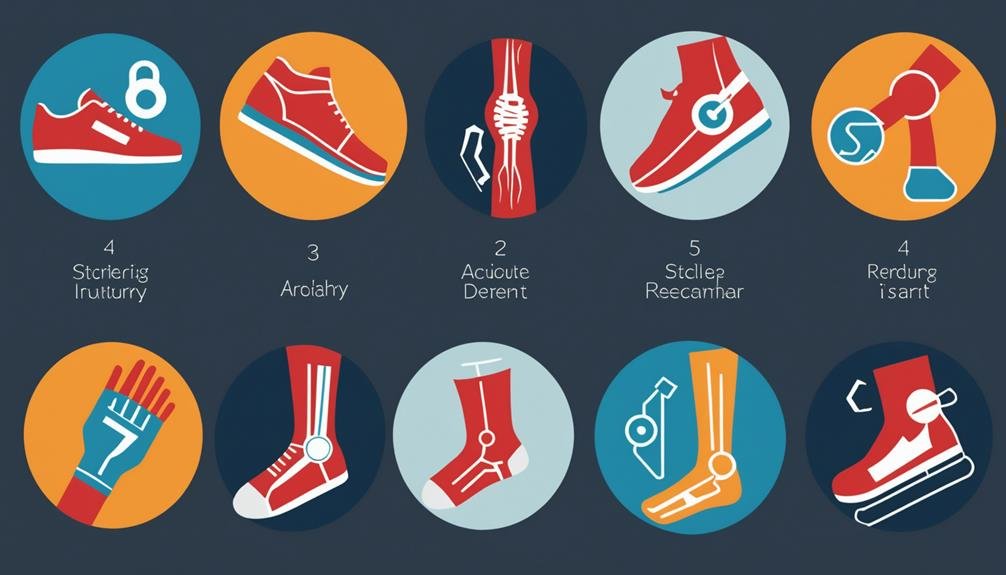You’ve probably experienced or heard of common acute injuries such as sprains, strains, fractures, and dislocations. But did you know that concussions and spinal injuries also fall under this category? These injuries can occur from sudden movements, overexertion, accidents, or even trauma. Ensuring correct warm-up techniques and using the right equipment can notably reduce their occurrence during physical activities or sports. Let’s take a closer look at these injuries, their symptoms, causes, and how to prevent them. Could a better understanding save you or someone you care about from potential harm?
Key Takeaways
- Acute injuries often include muscle strains and sprains, which require immediate treatment using the R.I.C.E. method.
- Fractures and dislocations are acute injuries that need urgent medical attention to avoid complications.
- Concussions and spinal injuries are severe acute injuries necessitating immediate care and possibly long-term monitoring.
- Common specific types of acute injuries include hamstring strain, ankle sprain, fractures, shoulder dislocation, and muscle tears.
- Using proper warm-up techniques and correct equipment can help prevent common types of acute injuries.
Understanding Acute Injuries
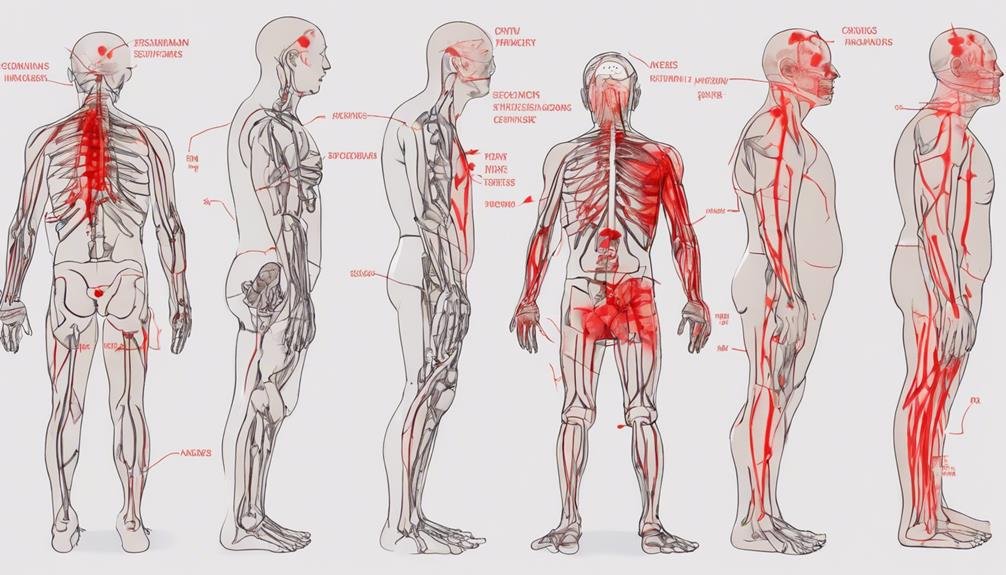
Understanding acute injuries is essential, especially if you engage in physical activities regularly. Acute injuries occur suddenly, often resulting from accidents or traumatic events during sports or workouts. Examples of these common sports injuries include fractures, muscle tears, dislocations, concussions, and severe sprains.
Unlike chronic injuries that develop over time, acute injuries can lead to immediate symptoms. Such symptoms include pain, swelling, bruising, and a limited range of motion in the affected area.
With an acute sports injury, you’re likely to know something’s wrong right away due to the instant discomfort and inability to use the injured part of your body as you normally would.
While acute injuries are less common than chronic ones, they can have significant consequences if not promptly and properly addressed. It’s important to seek immediate medical attention following an acute injury. Doing so can prevent further damage and ensure proper healing.
Don’t underestimate the role of physical therapy in the recovery process either. A qualified therapist can guide you through exercises that help restore function and prevent future injury. Remember, your health should always be your top priority.
Different Types of Acute Injuries
There’s a wide array of pivotal injuries that you could potentially encounter, especially if you’re an athlete or physically active. These types of injuries occur suddenly during physical activity and include muscle tears, sprains, strains, and bone fractures.
Common acute injuries in sports are concussions and dislocated joints, often arising from sudden impacts or falls. You might also experience muscle sprains and ligament tears, which can result in immediate pain, swelling, bruising, and a limited range of motion in the affected area.
Accidents, collisions, and sudden movements can cause other types of injuries, like fractures, contusions, and dislocations. These acute injuries can be severe and require immediate attention.
In contrast to chronic injuries that develop over time, an acute injury happens abruptly. That’s why it’s so essential to promptly treat these injuries and give your body ample rest to recover.
Whether it’s a muscle strain, a ligament sprain, or a joint dislocation, early treatment can make a significant difference in your healing process. Remember, taking care of your body is vital in any physical activity.
Symptoms of Acute Injuries
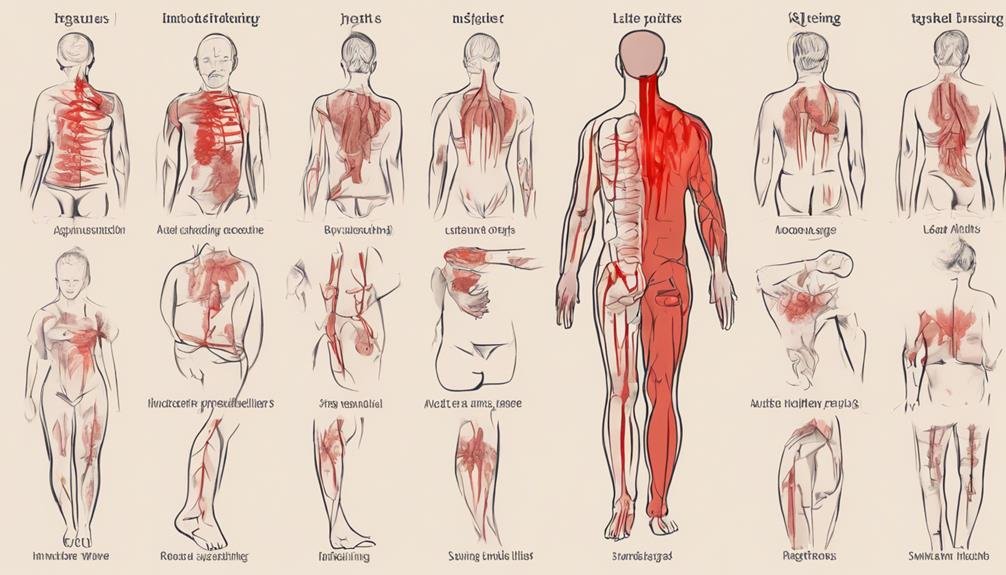
Now, let’s focus on the symptoms of acute injuries.
You might experience sudden pain, swelling, or even visible deformity, depending on the severity of the injury.
Understanding these signs is crucial as they often indicate the need for immediate medical evaluation and treatment.
Identifying Acute Injury Symptoms
Recognizing the symptoms of an acute injury is crucial in preventing further damage and ensuring you receive the necessary treatment. Acute injury symptoms often include sudden pain, swelling, and bruising at the site of injury. This sudden pain is typically sharp and intense, and it can worsen with movement or touch. If you’re experiencing these symptoms, you must seek immediate medical attention.
Another symptom to look out for is a limited range of motion. If you’re having difficulty moving a limb or joint, it could be due to an acute injury. Visible deformities are also a clear sign of acute damage, such as in the case of fractures or dislocations where there is a visible misalignment or abnormal bone angle.
To summarize, here’s a quick reference table for you:
| Acute Injury Symptoms | Description |
|---|---|
| Sudden Pain | Sharp, intense pain that worsens with movement |
| Swelling | Increased size or puffiness at the injury site |
| Bruising | Discoloration of the skin |
| Limited Range of Motion | Difficulty moving a limb or joint |
Pain Severity and Duration
Moving on from identifying acute injury symptoms, let’s focus on another key aspect – the seriousness and length of pain that these injuries often involve. Acute injuries often present with sudden, intense pain that can be debilitating. This pain is a clear signal from your body that something’s not right.
The seriousness can vary, but it’s generally strong enough to limit your capacity to move or bear weight on the affected area. Along with the pain, you’re likely to experience immediate swelling, tenderness, and possibly bruising at the site of the injury. These are your body’s initial reactions to the damage.
The swelling and tenderness add to the intensity of the pain you feel. The duration of these symptoms can differ from one person to another. Typically, they last a few days to a few weeks, depending on the nature of the acute injury. But, remember, the length of your symptoms doesn’t necessarily equate to the seriousness of your injury.
Seeking prompt medical attention is vital. It not only ensures a proper diagnosis but also guides the treatment process. Ignoring these symptoms can lead to further complications, prolonging your pain and recovery time.
Causes of Acute Injuries
When engaging in sports or physical activities, you might encounter sudden traumatic events that often lead to acute injuries. These injuries can be the result of falls, collisions, or direct blows that exert suddenly excessive force on your body.
Overuse injuries are another cause of acute injuries. Activities involving repetitive stress, particularly high-impact sports, can strain your body to the point of injury. Incorrect techniques, lack of warm-up, and inadequate protective gear can also contribute significantly to these injuries.
Accidents can cause acute injuries. Poor conditioning, fatigue, and environmental factors such as slippery surfaces or uneven terrain can make you more susceptible to these types of injuries.
Here’s a quick table summarizing the causes of acute injuries:
| Cause | Examples | Prevention |
|---|---|---|
| Trauma | Falls, collisions | Proper techniques, protective gear |
| Overuse | High-impact sports | Adequate rest, correct techniques |
| Accidents | Slippery surfaces | Awareness, conditioning |
Acute Injury Risk Factors
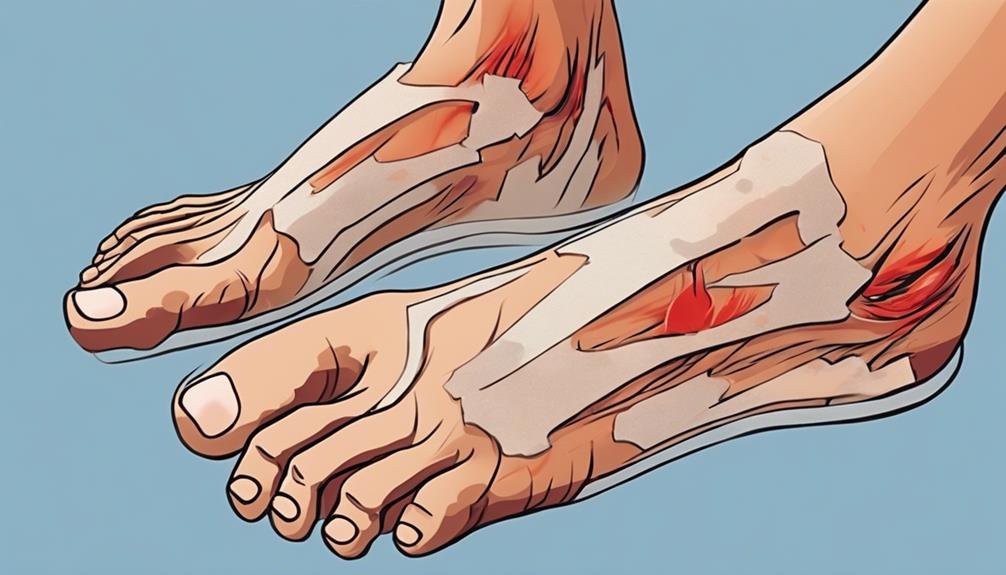
The risk of suffering an acute injury increases significantly under certain conditions. Sudden impacts or force on the body during physical activity are typical risk factors for acute injuries. This can occur due to a sudden fall or collision, particularly in sports or high-impact exercises. So, always make sure you’re aware of your surroundings during physical activities.
Incorrect techniques can also escalate your risk. Overexertion, a lack of proper warm-up, or poor conditioning might make you more susceptible. Rapid changes in intensity or direction during sports can lead to acute injuries, too. It’s essential to learn and stick to proper techniques, pacing yourself and warming up adequately before any intense physical activity.
Other risk factors may not be as apparent. Fatigue, improper equipment, and adverse environmental conditions can all contribute to the risk of acute injuries. You mightn’t think much about your tiredness, the shoes you’re wearing, or the icy patch on the ground, but they can all have a significant impact. By understanding these risk factors, you’re better equipped to prevent acute injuries.
Treating Common Acute Injuries
Immediate care for acute injuries often involves the R.I.C.E. method, a four-pronged approach that stands for Rest, Ice, Compression, and Elevation. This method can reduce pain and swelling, providing relief for minor injuries like muscle strains and sprains. But it’s important to bear in mind that some injuries may necessitate a medical evaluation to determine the extent of the damage.
| Injury Type | Immediate Treatment | When to Seek Medical Evaluation |
|---|---|---|
| Muscle Strains & Sprains | Use R.I.C.E. method | If pain persists, hinders mobility, or if injury doesn’t improve |
| Fractures & Dislocations | Stabilize, avoid movement, seek immediate care | Always |
| Concussions & Spinal Injuries | Minimize movement, seek immediate care | Always |
Fractures and dislocations typically require professional realignment or stabilization for proper healing. Severe acute injuries such as concussions or spinal injuries, on the other hand, require immediate medical attention to prevent further complications. Timely treatment of your acute injuries can help minimize long-term consequences and promote faster recovery. Always remember that when in doubt, it’s best to seek a medical evaluation to guarantee correct diagnosis and treatment.
Preventive Measures for Acute Injuries

As you navigate the domain of acute injuries, it’s important to know how to prevent them.
Let’s start by exploring the importance of proper warm-up techniques, the use of correct equipment, and the significance of rest periods.
These are all key factors in keeping you safe and injury-free.
Proper Warm-up Techniques
Every time you engage in physical activity, initiating your routine with proper warm-up techniques is crucial. These techniques aren’t just an introduction to your workout; they serve as your first line of defense against acute injuries. Warming up boosts blood flow to your muscles, improving flexibility, and decreasing the chance of muscle strains.
Now, what constitutes a good warm-up routine? It encompasses more than just a quick jog. Begin with light aerobic exercises like jumping jacks or a leisurely jog. This action stimulates your blood circulation, preparing your muscles for the upcoming activity.
Subsequently, progress to dynamic stretches such as arm circles and lunges. These differ from traditional static stretches that are held for an extended period. Instead, they involve active movements that enhance your range of motion and engage your muscles.
Step by step, ramp up the intensity of your warm-up. This readies your body for more demanding activity, reducing the risk of sudden injuries. Keep in mind, your warm-up should extend between 10 to 15 minutes. Anything shorter may not adequately prime your body, heightening the risk of acute injuries.
Utilizing Correct Equipment
When it comes to preventing acute injuries, your equipment plays a pivotal role. Appropriate footwear, for instance, can significantly decrease the risk of ankle sprains and fractures during physical activities. So, whether you’re running, playing basketball, or hiking, always opt for shoes that provide ample support and fit properly.
Moreover, donning protective gear like helmets and padding is crucial to preventing head injuries, concussions, and facial trauma. If you’re into high-risk sports like skateboarding or snowboarding, wrist guards become an integral part of your equipment. They’ll help protect against wrist sprains and fractures.
Choosing the proper equipment isn’t just about picking the right type, though. It’s also about ensuring the right size and fit.
Shoulder pads in football, for example, need to fit just right to minimize the impact of collisions and prevent shoulder dislocations.
Importance of Rest Periods
Quite a several athletes underestimate the importance of rest periods in preventing acute injuries. Don’t be one of them. Rest periods between your intense physical activities aren’t just downtime. They’re your body’s recovery time, a chance to repair damaged tissues and prepare for the next bout of activity.
Inadequate rest can lead to overuse injuries, including muscle strains, stress fractures, and tendonitis. These are injuries borne out of continuous strain on your body, a price you pay for pushing too hard without giving yourself a break. It’s not just about avoiding pain; it’s about maintaining your performance.
Without proper rest intervals, your performance may decline, and the likelihood of sudden acute injuries during sports or exercise increases.
Moreover, not giving your body enough time to rest can result in fatigue and decreased muscle function. This makes you more susceptible to acute injuries. Incorporating rest days into your workout routines isn’t just a suggestion—it’s essential for injury prevention and overall physical well-being. Remember, it’s about working smarter, not harder. Your rest periods are as important as your training days.
The Role of Physiotherapy in Recovery
Harnessing the power of physiotherapy can speed up your recovery from acute injuries greatly. Physiotherapy is essential in restoring your strength and mobility post-injury. It’s not just about healing, but also about preventing potential long-term complications.
Passive physiotherapy treatments like manual therapy and acupuncture are commonly used to address acute injuries. They’re effective in promoting healing, but that’s only half the battle won. Active physiotherapy, which includes prescribed exercises, is equally important. It helps you regain strength and flexibility, both of which are crucial for a full recovery.
Rehabilitation is a key part of physiotherapy. It’s not just about getting you back on your feet, but ensuring you’re better than before. The goal is to enhance your overall health, form, and function. So, don’t underestimate the role of physiotherapy in your recovery journey.
In a nutshell, physiotherapy is more than a reactive measure. It’s a proactive strategy aimed at facilitating your recovery from acute injuries, rebuilding your strength, reinstating your mobility, and steering you toward a healthier future. Remember, your recovery is in your hands, but a physiotherapist can guide you through it.
Acute Vs. Chronic Injuries
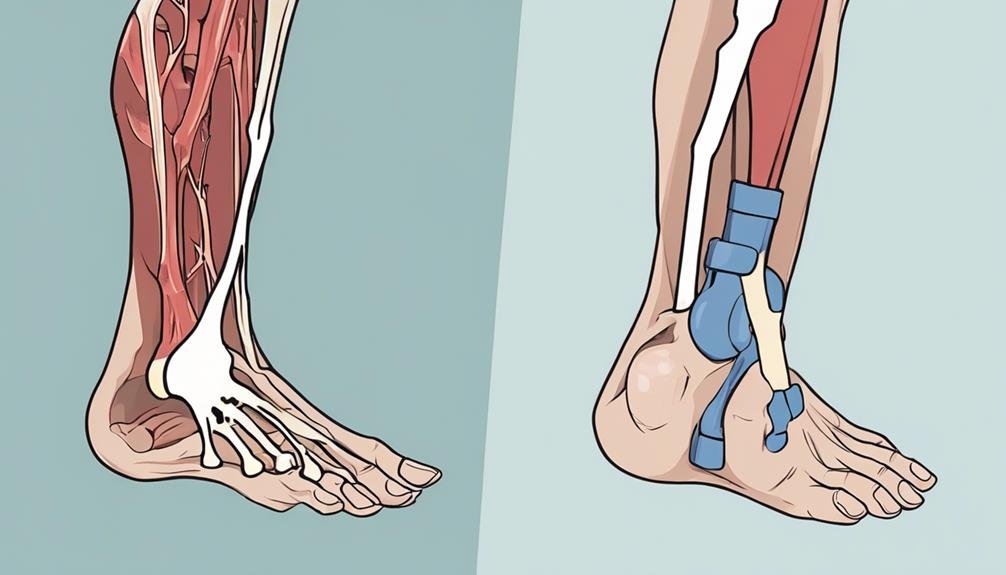
You’ve likely heard the terms ‘acute’ and ‘chronic’ about injuries. But what exactly sets them apart? Let’s take a moment to understand the key differences, and how they impact your body and recovery process.
Understanding Acute Injuries
In understanding the nature of acute injuries, it’s important to compare them with chronic injuries. Acute injuries occur suddenly, often during physical activities or as a result of traumatic events. They’re different from chronic injuries, which develop over time.
When you experience an acute injury, you’ll feel immediate pain. This could be a fracture, muscle tear, dislocation, sprain, or even a concussion. You may also notice visible signs like swelling or bruising. These injuries can be quite serious, so it’s essential not to ignore them.
Acute injuries might be less common than chronic ones, but they can have significant consequences if left untreated. That’s why seeking medical attention should be your first step after the injury. Getting appropriate care promptly can prevent complications and help you recover more effectively.
Chronic Injuries Explained
Exploring the world of chronic injuries can be quite complex, especially when contrasted with acute injuries. Unlike acute injuries that occur suddenly, chronic injuries develop over time. They’re the result of repetitive stress or overuse of your body. Common culprits include tendinitis, stress fractures, and muscle strains that worsen with continued activity.
Poor biomechanics, training errors, or inadequate rest periods in between activities often lead to these types of injuries. You might experience persistent pain, reduced performance, and even long-term damage if you don’t manage them properly.
Treatment for chronic injuries isn’t a one-size-fits-all solution. It could involve rest, physical therapy, or modifying your activities. Addressing underlying biomechanical issues is also essential.
Case Studies of Acute Injuries
While engaging in sports or demanding physical activities, you might encounter acute injuries, as exemplified in numerous case studies. Take, for example, a soccer player who sustains a hamstring strain during a match. This type of acute injury can occur during a fast sprint or a sudden stop, causing a sharp pain in the back of the thigh.
Another case study involves a basketball player who experiences an ankle sprain while jumping for a rebound. The player lands awkwardly, causing the ankle to roll inward or outward, resulting in a sprain. This acute injury is common in sports that involve jumping and landing.
Beyond team sports, acute injuries also occur in individual activities. A skier might fracture a bone after a fall on the slopes, or a tennis player could dislocate their shoulder during a serve. Even weightlifters aren’t immune, with some tearing a muscle while attempting a heavy lift.
These case studies demonstrate that acute injuries can happen in any sport or physical activity.
Frequently Asked Questions
What Are the Most Common Acute Injuries?
You’re likely to encounter acute injuries like fractures and sprains from sports injuries, workplace accidents, or slip and falls. Even car collisions, recreational activities, and household mishaps can result in such sudden injuries.
What Are the 4 Most Common Types of Injuries?
You’re likely to encounter sprains, strains, fractures, and dislocations in sports injuries, workplace accidents, or slip and falls. Even car crashes or recreational activities can cause these common, exercise-related acute injuries.
Which Injury Is Considered an Acute Injury?
You’d consider injuries like concussions, broken bones, or sprains as acute. They often occur from sports, car accidents, workplace mishaps, slips, falls, or even just around the house during everyday activities.
What Are the 4 Common Chronic Injuries?
You’re asking about chronic injuries. They’re often due to overuse, repetitive strain, or long-term damage. The four common ones are tendinitis, stress fractures, bursitis, and shin splints. These can lead to musculoskeletal disorders or degenerative conditions.
Conclusion
In wrapping up, you’ve learned about various acute injuries, their symptoms, causes, and risk factors. Remember, proper warm-up and using the right equipment can help prevent these injuries. If you do get injured, physiotherapy plays a pivotal role in recovery. Understand the difference between acute and chronic injuries and learn from case studies. Stay safe, and stay informed, and you’ll markedly reduce your risk of these injuries.
